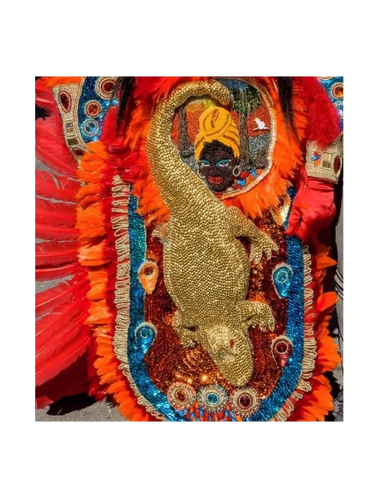Big Queen Yellow Pocahontas Black Masking Indians
Dianne Honore' is the current Big Queen of the legendary Yellow Pocahontas Hunters Black Masking Indian Tribe. To mask in the tradition you are either born into it or personally invited and instructed. While the exact origin of the Yellow Pocahontas tribe is unknown, we do know that Dianne's ancestor, Eugene Honore, was Big Chief of the Yellow Pocahontas ca. 1920s. Eugene is also credited with writing the Indian prayer song, Indian Red as well as other rhythms used in some chants in the practice. Allison "Tootie" Montana stepped in to take the tribe in the 1940s. Big Chief Tootie then gave the tribe to his son Darryl Montana in 1996. A tribe always belongs to whomever is the Big Chief at that time. Currently Darryl Montana owns the Yellow Pocahontas. It continues under his leadership and direction. A tribe can consist of any number of members. Tribe members can also be disenrolled for several reasons including, misrepresentation, suiting with an outside tribe, disregard for specific tribal duties, over-stepping the Chief, etc. Sometimes a tribe will go dormant if a Chief so chooses. He can also hand it off to anyone he selects. It is not a family based tradition. It is a community based tradition so, future Chiefs and members are not always related. Each tribe stands on their own as there is no governing body over all tribes. Some organizations were founded for the purpose of various tribes coming together for specific goals but not all tribes belong to these organizations.
Big Chief is Darryl Montana has been involved in the tradition for over 63 years. His Father was a legendary Chief, Allison "Tootie" Montana who is credited with changing the tradition from violence to elaborate suit creation. He died in City Hall while fighting for the rights of Black Masking Indians.
Black Masking Indians are tribes or groups of mostly men and women who create elaborate "suits" each year from thousands of beads and various feather types. The practice includes secret rituals, chants, drumming (tambourines), and movement. It is ancestral. It is deeply spiritual. It was not until more recent history that the tradition of "suit" making, certain beading styles and feather work were considered art. They are each specially designed each year, then it can take up to a year to create as they are hand sewn bead by bead. The cost can range from $1,000-$10,000 for supplies alone and each Indian should sew her/his own "suit".
Photo Gallery





